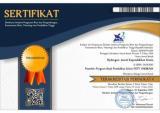Development of Particle Board Biocomposite From Coffee Skin and Tofu Dregs With Polyethylene Plastic Adhesive As Furniture Interior
Abstract
Keywords
Full Text:
PDFReferences
Aminah, Setyawati, D., & Yani, A. (2018). Sifat Fisik dan Mekanik Papan Partikel Dari Limbah Kayu Acacia crassicarpa Pada Beberapa Ukuran Partikel dan Konsentrasi Urea Formaldehida. Jurnal Hutan Lestari, 6(3), 557–568.
Anggraini, R., Khabibi, J., & Adelka, Y. F. (2021). Karakteristik Papan Partikel dari Campuran Limbah Akasia (Acacia mangium Willd.) DAN KULIT KELAPA MUDA (Cocos nucifera L.). Jurnal Silva Tropika, 5(1), 366–381. https://doi.org/10.22437/jsilvtrop.v5i1.12170
Badan Standarisasi Nasional. (2006). SNI 03-2105-2006 : Mutu Papan partikel. Badan Standarisasi Nasional.
Barbu, M. C., Sepperer, T., Tudor, E. M., & Petutschnigg, A. (2020). Walnut and hazelnut shells: Untapped industrial resources and their suitability in lignocellulosic composites. Applied Sciences (Switzerland), 10(18). https://doi.org/10.3390/APP10186340
Chamas, A., Moon, H., Zheng, J., Qiu, Y., Tabassum, T., Jang, J. H., Abu-Omar, M., Scott, S. L., & Suh, S. (2020). Degradation Rates of Plastics in the Environment. ACS Sustainable Chemistry and Engineering, 8(9), 3494–3511. https://doi.org/10.1021/acssuschemeng.9b06635
Dotun, A. O., Adesoji, A. A., & Oluwatimilehin, A. C. (2018). Physical and mechanical properties evaluation of particle board produced from saw dust and plastic waste. International Journal of Engineering Research in Africa, 40, 1–7. https://doi.org/10.4028/www.scientific.net/JERA.40.1
Effendi, Z & Hatta, L. (2013). Kandungan Nutrisi Hasil Fermentasi Kulit Kopi (Studi Kasus Desa Air Meles Bawah Kecamatan Curup Timur). BPTP Bengkulu, 1 (1)(2005), 1–5.
El-Sherif, D. M., Eloffy, M. G., Elmesery, A., Abouzid, M., Gad, M., El-Seedi, H. R., Brinkmann, M., Wang, K., & Al Naggar, Y. (2022). Environmental risk, toxicity, and biodegradation of polyethylene: a review. Environmental Science and Pollution Research, 29(54), 81166–81182. https://doi.org/10.1007/s11356-022-23382-1
Fauziah, ., Wahyuni, D., & Lapanporo, B. P. (2014). Analisis Sifat Fisik dan Mekanik Papan Partikel Berbahan Dasar Sekam Padi. Positron, 4(2), 60–63. https://doi.org/10.26418/positron.v4i2.8728
Fitria, L. N., Susanto, H., & Istirokhatun, T. (2017). Penyisihan Karbosulfan Dalam Air Dengan Menggunakan Membran Nanofiltrasi. Jurnal Teknik Lingkungan, 6(1), 1–17.
Hasan, A., Yerizam, M., & Kusuma, M. N. (2020). Bagasse ( Saccharum officinarum ) Particle board with high density polyethylene adhesive. Jurnal Kinetika, 11(03), 8–13.
Indrayanti, L., Siska, G., & Sijabat, F. (2023). Uji Pendahuluan Sifat Fisika Mekanika Papan Partikel Kayu Kawui (Vernonia Arborea) dengan Tiga Persentase Perekat PVAc (Polyvinyl Acetate). Juni, 17(1), 27–36.
Issac, M. N., & Kandasubramanian, B. (2021). Effect of microplastics in water and aquatic systems. Environmental Science and Pollution Research, 28(16), 19544–19562. https://doi.org/10.1007/s11356-021-13184-2
Iswanto, A. H., Coto, Z., & Effendy, K. (2008). Pengaruh Perendaman Partikel terhadap Sifat Fisis dan Mekanis Papan Partikel dari Ampas Tebu (Saccharum officinarum). Perennial, 4(1), 6. https://doi.org/10.24259/perennial.v4i1.176
Jarlis, R. (2022). Mechanical Properties of Coconut Particle Board with Variation of Material Composition. Asian Journal of Science Education, 4(1), 40–50. https://doi.org/10.24815/ajse.v4i1.25325
Kencanawati, I., Saslina, T., Mairisiska, T., & Anzalina, H. (2023). Pemanfaatan Limbah Kulit Kopi : Strategi Pengolahan. 03(02), 47–55.
Krumins, J. A., Vamza, I., Dzalbs, A., & Blumberga, D. (2024). Particle Boards from Forest Residues and Bio-Based Adhesive. Buildings, 14(2). https://doi.org/10.3390/buildings14020462
Kumar Gupta, K., & Devi, D. (2019). Biodegradation of low density polyethylene by selected bacillus sp. Gazi University Journal of Science, 32(3), 802–813. https://doi.org/10.35378/gujs.496392
Kusumah, S. S., Umemura, K., Guswenrivo, I., Yoshimura, T., & Kanayama, K. (2017). Utilization of sweet sorghum bagasse and citric acid for manufacturing of particleboard II: influences of pressing temperature and time on particleboard properties. Journal of Wood Science, 63(2), 161–172. https://doi.org/10.1007/s10086-016-1605-0
Maulida, C. R., Mursal, & Ismail, I. (2021). Studi pemanfaatan ampas kopi untuk papan partikel. J. Aceh Phys. Soc, 10(2), 48–52. https://doi.org/10.24815/jacps.v10vi2.19063
Meldayanoor, Muhammad Indra Darmawan, N. (2020). Pembuatan Papan Komposit dengan Memanfaatkan Limbah Pelepah Kelapa Sawit dan Plastik Polyethylene Terephthalate (PET) Daur Ulang. Jurnal Teknol.Ogi Agro-Industri, 7 (1), 56–69. https://doi.org/10.34128/jtai.v7i1.116
Nasution, W. M., & Mora, M. (2018). Analisis Pengaruh Komposisi Partikel Ampas Tebu dan Partikel Tempurung Kelapa terhadap Sifat Fisis dan Mekanis Komposit Papan Partikel Perekat Resin Epoksi. Jurnal Fisika Unand, 7(2), 117–123. https://doi.org/10.25077/jfu.7.2.117-123.2018
Odusote, J. K., Onowuma, S. A., & Fodeke, E. A. (2016). Production of paperboard briquette using waste paper and sawdust. Journal of Engineering Research, 13(1), 80–88. https://doi.org/10.24200/tjer.vol13iss1pp80-88
Ogunjirin, O. A., Ola, O., Farounbi, A. J., & Ogini, F. U. (2021). Development of Improved Coffee Bean Depulping Machine. International Journal of Research in Agricultural Sciences, 8(1), 2348–3997.
Ohijeagbon, I. O., Adeleke, A. A., Mustapha, V. T., Olorunmaiye, J. A., Okokpujie, I. P., & Ikubanni, P. P. (2020). Development and characterization of wood-polypropylene plastic-cement composite board. Case Studies in Construction Materials, 13, e00365. https://doi.org/10.1016/j.cscm.2020.e00365
Permana, E., Nelson, N., Asti Rahayu, M., Arsa, D., Alim, K., Eka Wijaya, D., Nurdin Hidayat, A., & Salsa Rusmana, A. (2023). Pelatihan Pembuatan Lilin Aromaterapi Kulit Kopi Berbasis Minyak Jelantah Di Desa Mukai Pintu Kabupaten Kerinci. Literasi Jurnal Pengabdian Masyarakat Dan Inovasi, 3(2), 620–625. https://doi.org/10.58466/jurnalpengabdianmasyarakatdaninovasi.v3i2.1111
Pratama Nanda, Djamas Djusmaini, & Darvina Yenni. (2016). Pengaruh Variasi Ukuran Partikel TerhadapNilai Konduktivitas Termal Papan Partikel Tongkol Jagung. Pillar of Physics, 7(April), 25–32.
Rahmawati, A. (2015). Pengaruh Penggunaan Plastik Polyethylene (PE) dan High Density Polyethylene (HDPE) Pada Campuran Lataston - WC Terhadap Karakteristik Marshall. Jurnal Ilmiah Semesta Teknika, 18(2), 147–159. https://journal.umy.ac.id/index.php/st/article/view/1816
Said, M., Fuadi, N., & Dzikriansyah, M. F. (2021). Karakterisasi Sifat Fisis Papan Partikel Sabut Kelapa-Serat Pelepah Lontar. Jurnal Fisika Dan Terapannya, 8(2), 1–12. https://doi.org/10.24252/jft.v8i1.24814
Sari, A. M., Ab, S., Yulianti, N. O., & Permana, Y. Y. (2018). Terhadap Yield Tepung Ampas Tahu. Prosiding Seminar Nasional Sains Dan Teknologi, 1–5.
Siswati, N. D., Yatim, M., & Hidayanto, R. (2012). Bioetanol Dari Limbah Kulit Kopi Dengan Proses Fermentasi Bioethanol From Coffe Peel Waste With Fermentation Process. Teknik Kimia, 1, 1–4.
Situmorang, J., & Zarzani, T. R. (2023). Aspek Hukum Terhadap Pertanggung Jawaban Pelaku Tindak Pidana Illegal Looging. Innovative: Journal Of Social Science Research, 3(4), 7744–7756. https://j-innovative.org/index.php/Innovative/article/view/4518
Suryani, R. R. (2024). Pemanfaatan protein ampas tahu sebagai bahan dasar pembuatan Bioplastik (Plastik Biodegradable). UIN Sunan Ampel Surabaya.
Tiago, G. A. O., Mariquito, A., Martins-Dias, S., & Marques, A. C. (2023). The problem of polyethylene waste – recent attempts for its mitigation. Science of the Total Environment, 892(June), 164629. https://doi.org/10.1016/j.scitotenv.2023.164629
Widyasanti, A., & Muharram, A. (2023). Pemanfaatan Limbah Kulit Kopi Dan Praktik Pembuatan Sabun Cascara Kopi. Sawala : Jurnal Pengabdian Masyarakat Pembangunan Sosial, Desa Dan Masyarakat, 4(2), 54. https://doi.org/10.24198/sawala.v4i2.46566
DOI: https://doi.org/10.33394/hjkk.v12i6.13802
Refbacks
- There are currently no refbacks.

This work is licensed under a Creative Commons Attribution-ShareAlike 4.0 International License.





